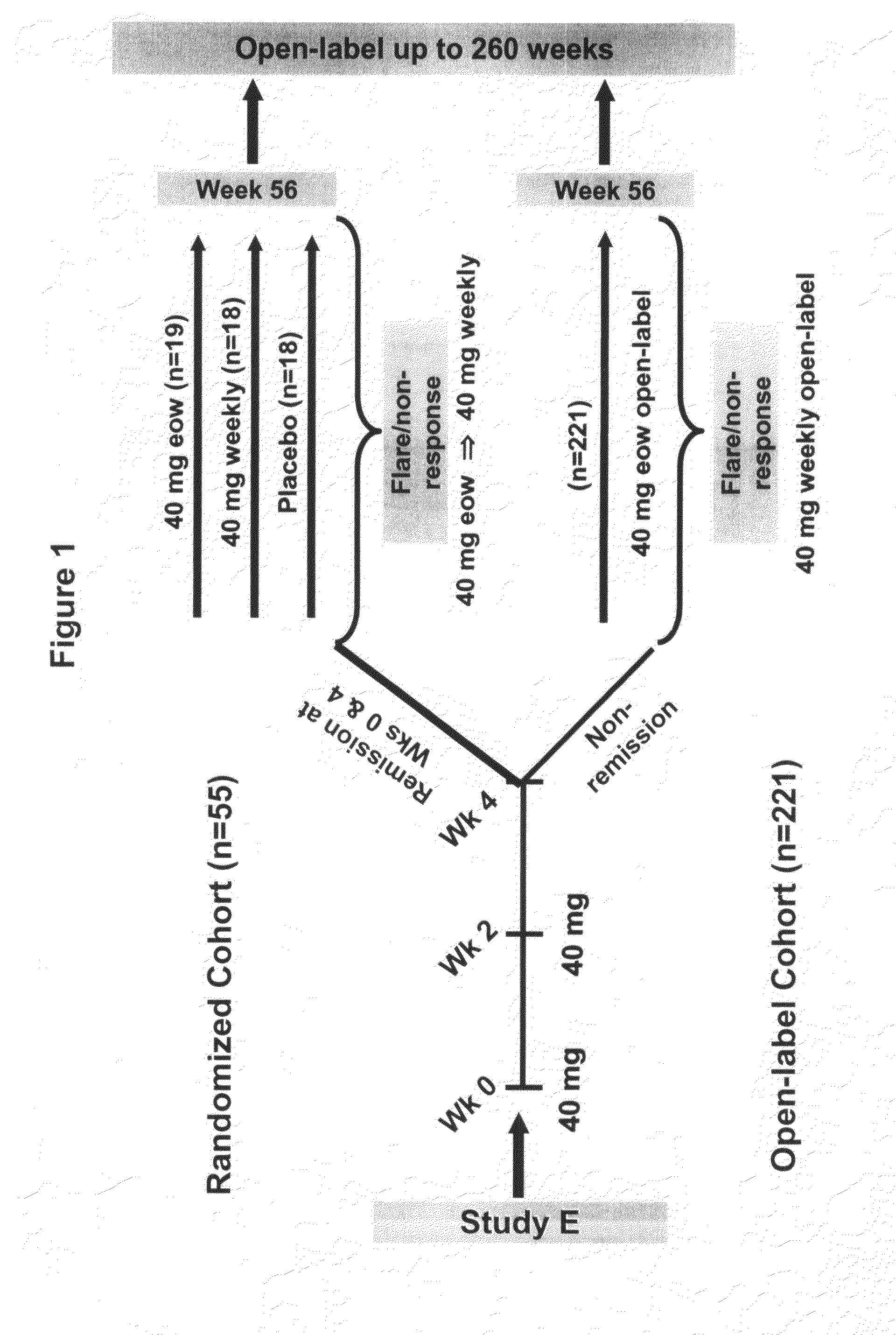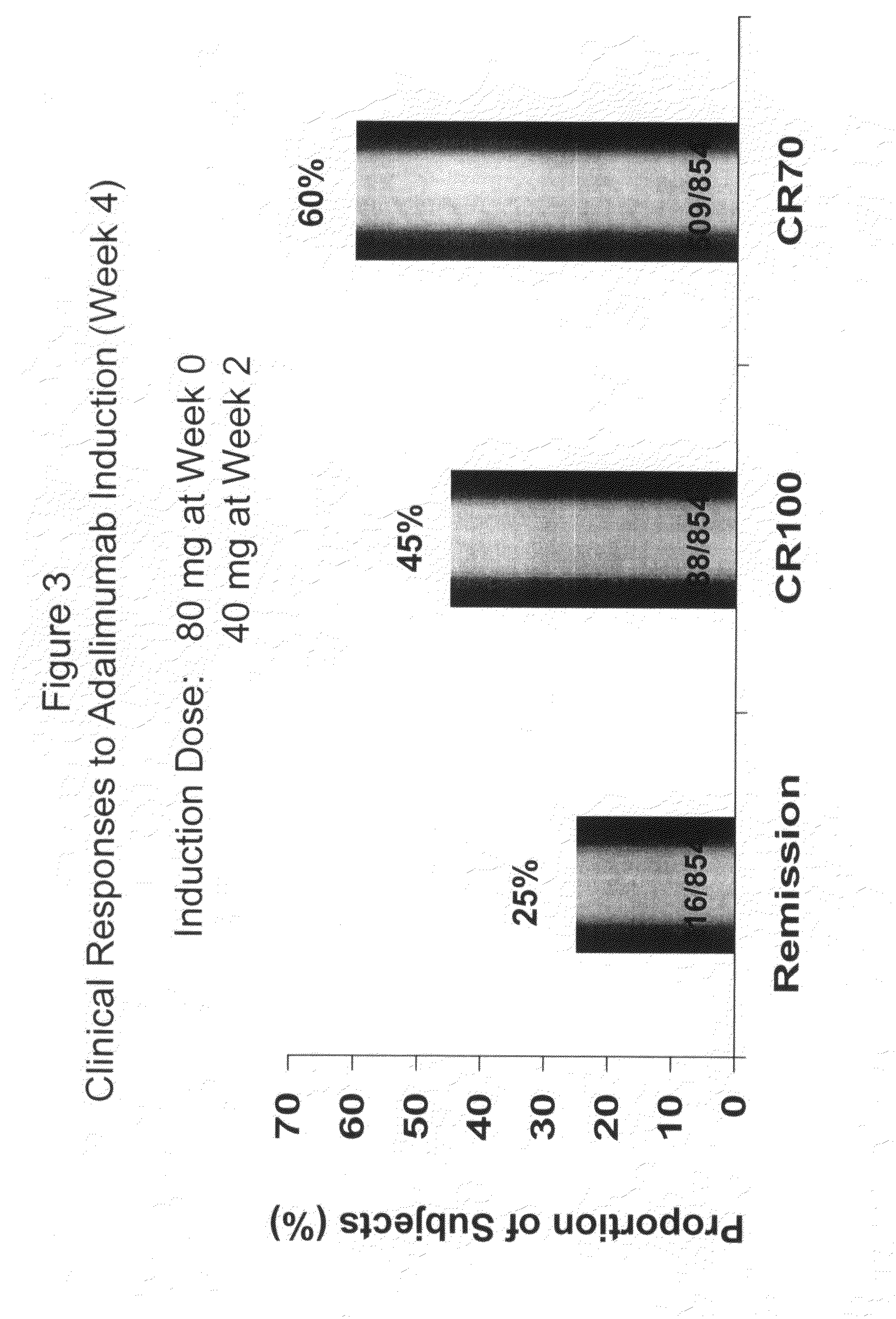Uses and compositions for treatment of CROHN'S disease
- Summary
- Abstract
- Description
- Claims
- Application Information
AI Technical Summary
Benefits of technology
Problems solved by technology
Method used
Image
Examples
example 1
Adalimumab Therapy in Patients With Crohn 's Disease
[0290]Study E was a 4-week randomized controlled study of adalimumab in the induction of remission in patients with active Crohn's disease (CD). Immunosuppressant (IMM)—azathioprine, 6-MP, or methotrexate—use was permitted if patients entered the study on a stable IMM dose for 12 weeks prior to screening. IMM use did not influence the response to adalimumab in Study E.
[0291]One goal of the following study was to assess the effect of concomitant IMM on the efficacy of adalimumab over 1 year. Study F was also designed to evaluate adalimumab's ability to maintain clinical remission. The study design for Study F is shown in FIG. 1.
[0292]Inclusion criteria for Study F included a diagnosis of CD for at least 4 months and moderately to severely active CD (CDAI 220-450). Stable doses of CD medications (steroids, immunosuppressive agents, aminosalicylates, antibiotics) were allowed. Patients also had to have completed the previous 4-week ad...
example 2
Adalimumab Maintains Improvement in Inflammatory Bowel Disease Questionnaire (IBDQ) Scores Over 1 Year Following the Initial Attainment of Remission in Patients with Moderately to Severely Active Crohn 's Disease
[0302]Adalimumab, a fully human anti-TNF monoclonal antibody, is approved for the treatment of rheumatoid arthritis and psoriatic arthritis. IBDQ measures disease-related functional changes in patients with IBD. A Total IBDQ>170 score has been correlated to clinical remission (CDAIGastroenterology 1994;106:287-96).
[0303]In Study E, a 4-week randomized trial, the efficacy of adalimumab in the induction of remission in patients with Crohn's disease (CD) was demonstrated, where a mean improvement in patient function and in disease activity were highly correlated (p<0.0001). Patients treated with 160 / 80 mg or 80 / 40 mg adalimumab demonstrated statistically significant improvements in mean CDAI and total IBDQ vs. placebo at Week 4. Emotional function, bowel system, and systemic di...
example 3
TNFα Antibody Induces and Maintains Clinical Response and Remission in Patients with Active Crohn 's Disease
[0313]This study examined the efficacy of the TNFα antibody adalimumab to induce and maintain a clinical response and remission of the intestinal disorder Crohn's disease. The objective of this study was to determine the efficacy and safety of adalimumab 40 mg eow vs weekly doses for maintenance of clinical remission in moderate / severe Crohn's disease.
[0314]The overall study design was a double-blind, placebo-controlled trial, which included an open label (OL) 4-week induction period. In the OL induction period, patients were administered 80 mg at week 0 (baseline), 40 mg at week 2. All patients (responders and nonresponders) were randomized at week 4, and patients were stratified at Week 4 according to clinical response (CDAI decrease ≧70 points (CR70)). A 52 week blinded phase followed, where all patients (responders and nonresponders) were randomized to 1 of 3 maintenance t...
PUM
| Property | Measurement | Unit |
|---|---|---|
| Fraction | aaaaa | aaaaa |
| Fraction | aaaaa | aaaaa |
| Fraction | aaaaa | aaaaa |
Abstract
Description
Claims
Application Information
 Login to View More
Login to View More - R&D
- Intellectual Property
- Life Sciences
- Materials
- Tech Scout
- Unparalleled Data Quality
- Higher Quality Content
- 60% Fewer Hallucinations
Browse by: Latest US Patents, China's latest patents, Technical Efficacy Thesaurus, Application Domain, Technology Topic, Popular Technical Reports.
© 2025 PatSnap. All rights reserved.Legal|Privacy policy|Modern Slavery Act Transparency Statement|Sitemap|About US| Contact US: help@patsnap.com



